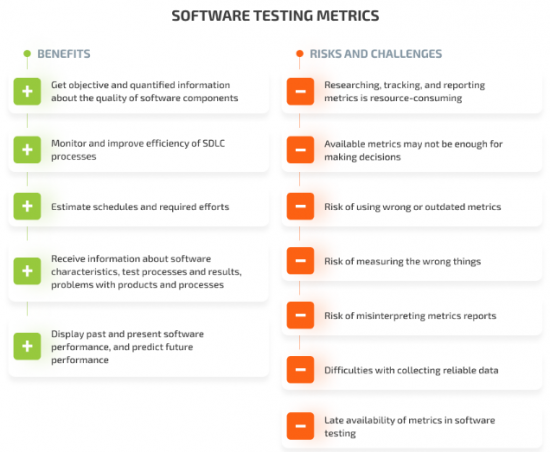


Ensuring thorough quality assurance (QA) and testing processes for your software before its release is essential. These activities help you detect and eliminate various defects as well as make sure your solution performs flawlessly. However, building and executing an efficient software testing strategy can be challenging when your project has a limited budget and time frame.
The devil is in the details. Metrics are an effective way to get quantitative information about the quality of your product and processes, your project’s progress, and the skill set of people on your team. But with a great variety of these metrics, it’s not always obvious which to choose.
This article contains recommendations on how to choose metrics for making proactive decisions. You’ll find the most important types of testing metrics followed by real-world examples with explanations.
This article will be useful for test and QA specialists as well as for project managers who want to improve their software testing strategies and learn more about choosing, tracking, and reporting software testing metrics.
Software testing metrics are quantifiable indicators of the progress, quality, and productivity of the testing process. They help test engineers check how efficiently software and its components work.
Metrics are an important part of many quality models and standards including Capability Maturity Model Integration (CMMI), Test Maturity Model Integration (TMMI), and Test Process Improvement (TPI).
Test engineers use software testing metrics to:
However, there are hidden risks and challenges to using software testing metrics:

By keeping these risks and challenges in mind, test engineers can efficiently plan their work with testing metrics and avoid problems when applying metrics during the testing process.
There are no universal metrics or best practices you can apply to every process. When choosing which metrics to use, test engineers rely on the objectives of the particular test process.
Identifying objectives for the testing process and actual software quality may be challenging, as QA and test specialists might have unrealistic expectations for their projects (such as finding and fixing all code defects) or might underestimate how many hours testing will actually take.
One way to choose test objectives is by choosing from the four most common as defined by Rex Black in Metrics for Software Testing: Managing with Facts, Part 1: The How and Why of Metrics:
You can have other objectives for your project.
With that in mind, let’s discuss the general strategy for working with software testing metrics.
In short, your goals define the set of metrics you need to use for each specific project. Once your metric set is formalized, you need to define your processes for tracking, reporting, and decision-making. Let’s take a close look at each step:

It’s better to choose a limited set of relevant metrics based on specific objectives for your project, process, or product. Selecting these metrics can be far from easy, as effective metrics should be:
It’s best to start with basic metrics and apply complex ones when you need more details. A good practice is to use a set of metrics that balance and complement each other so they reflect the entire picture. Once QA specialists select testing metrics, they present them to stakeholders and team members to avoid confusion when metrics are discussed.
Tracking metrics is the process of collecting data and interpreting results.
You should determine who will collect data, when and how they will do so, and where that data will be stored. After that, you need to define methods for analyzing and visualizing your data. Data analysis usually requires patience to carefully investigate possible divergence from expectations in actual measurements and understand reasons for that divergence.
You can use products that help you at least partially automate metrics tracking. There are both commercial test management solutions like TestRail, Jira, and Zephyr, as well as free tools such as filters in your ticketing system and Google Sheets.
It’s essential to track metrics regularly during the testing process and even after the product release to further improve software quality. You can also analyze results in comparison with previous releases and targeted values to see progress.
QA and test specialists must verify the information received from tracking metrics before reporting it. Measurements for a metric may not reflect the true status of the test process or may convey an overly positive or negative trend.
Before any data is presented, test engineers have to review it for both accuracy and the message it’s likely to convey. Besides, it’s a good idea to validate measurements over time, as a specific metric on its own may be interpreted differently than agreed in the metric definition phase.
The main objective of reporting software testing metrics is to provide an immediate understanding of the state and quality of a project for management purposes.
Metrics are usually reported during meetings of team members or stakeholders using visualizations. You can also share information about metrics using your corporate content management platform so they’re available whenever necessary.
